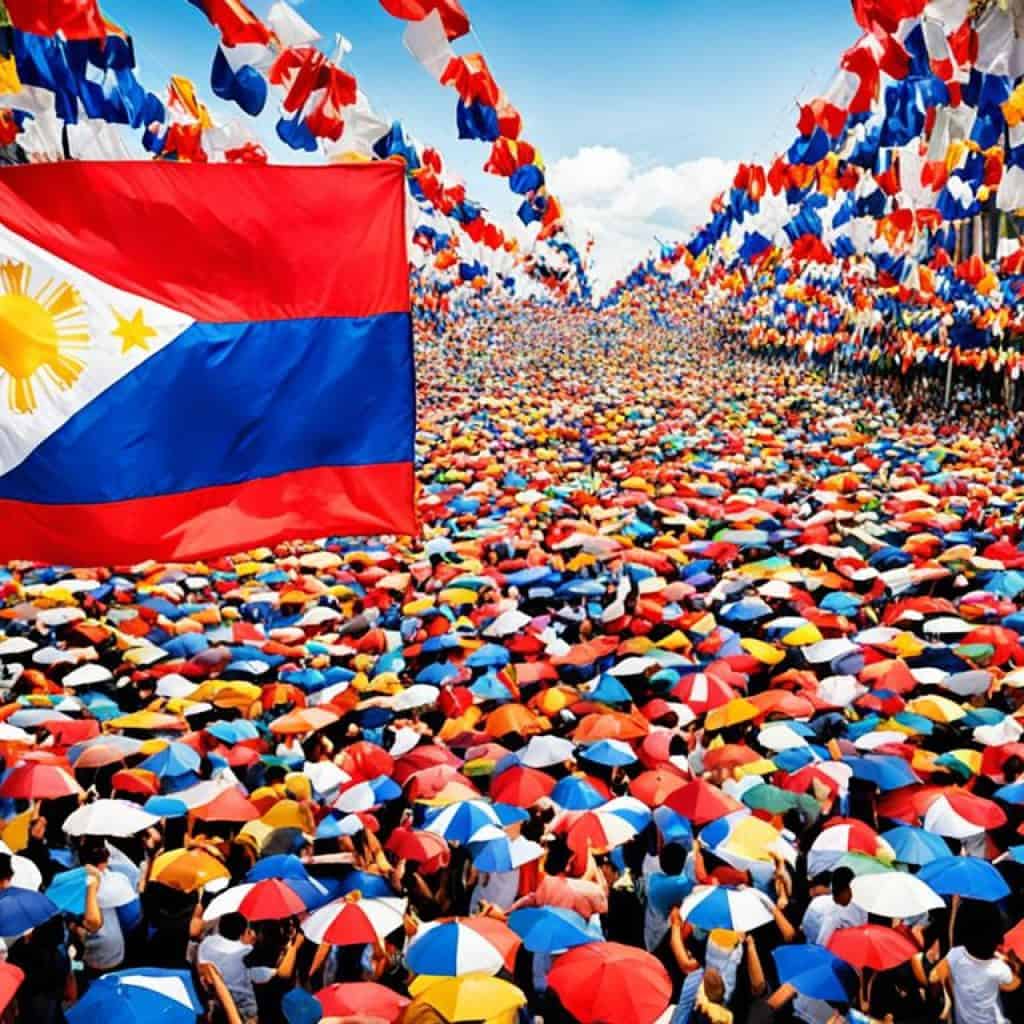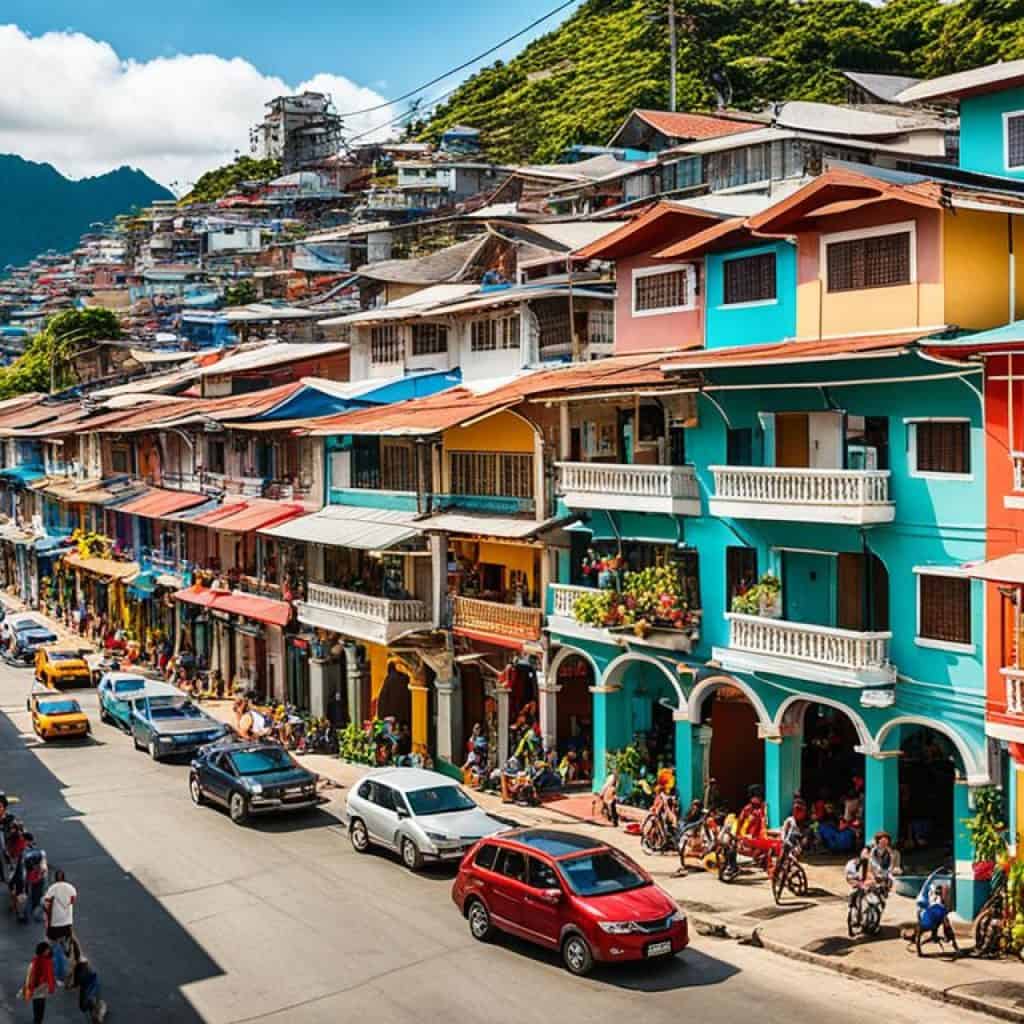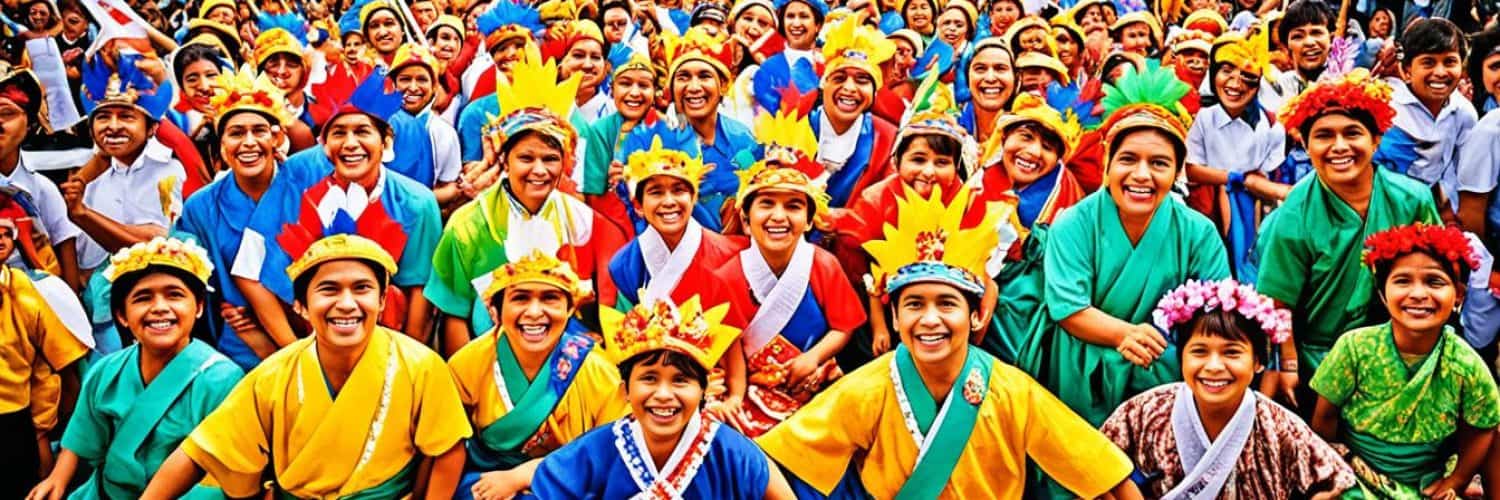Did you know the Philippines has two official languages, not just one? English is common in many areas. But Filipino is the nation’s language. It shows the Philippines’ rich language variety. What makes Filipino stand out from Tagalog? Let’s dive into its history, features, and local dialects. See how language holds a special place in Filipino culture.
National and Official Languages in the Philippines
The Philippines is rich in culture and has two main languages: English and Filipino. Filipino stands as the national language, showcasing unity. English is also key, used widely in government, the press, and official settings.
Filipino is very important for communication among Filipinos. It helps people from different areas talk and understand each other.
English has a big role in education, business, and the media. This is because of past ties with the USA and its global role.
Both Filipino and English shape the Philippines’ language scene. They highlight its diverse culture and international relationships.
Filipino vs. Tagalog
Filipino and Tagalog are often thought to be the same, but they are not. Tagalog became the national language of the Philippines in 1937. It was the main language spoken in Manila then. By 1973, the Philippine constitution was updated, and Tagalog got a new name, Pilipino, and later evolved into Filipino. Filipino includes parts from other Philippine languages and English, Spanish, and Malay.
Tagalog is the foundation for Filipino, but Filipino builds on this. It aims to include various dialects and cultures from the Philippines. This makes it easier for different linguistic communities in the country to communicate.
The change from Tagalog to Filipino helped the language grow. It now includes influences from other languages. This shows the rich cultural diversity of the Philippines. The growth of Filipino as the national language has helped unite Filipinos. It promotes a shared identity among them.
Usage and Regional Languages
Filipino, the standardized form of Tagalog, is mainly used in Metro Manila, the Philippines’ capital. The Philippines is full of different languages spoken across its many regions. This shows the country’s rich linguistic diversity.
Some of these regional languages include:
- Bicolano
- Pangasinan
- Waray-Waray
- Ilocano
- Hiligaynon
Local communities speak these regional languages. They are used in business, education, government, and media too.
The Philippines has over 170 languages and many dialects. This reflects its unique culture and the various ethnic groups in different areas.
Language Usage in Different Sectors
The use of regional languages varies by region and sector. For example:
| Region | Regional Language | Sector |
|---|---|---|
| Bicol Region | Bicolano | Local government, education, media |
| Pangasinan Region | Pangasinan | Business, education |
| Eastern Visayas Region | Waray-Waray | Local government, education, media |
| Ilocos Region | Ilocano | Local government, education, media |
| Western Visayas Region | Hiligaynon | Business, education |
Linguistic Diversity in the Philippines
“The Philippines boasts a wide array of languages, each with its own unique characteristics and cultural significance. This linguistic diversity not only contributes to the rich tapestry of Filipino culture but also demonstrates the country’s commitment to preserving its heritage.”
Exploring the Philippines’ linguistic diversity helps us understand each region’s unique traditions and culture. It reminds us of the country’s vibrant multicultural identity. It also celebrates the resilience and adaptability of its people.
Writing Systems and Dialects
The Philippines is rich in history with its writing systems. One of the oldest is Baybayin. It was used before the country was colonized and is cherished even today. This ancient script uses different characters for sounds and syllables.
In the Philippines, people speak many dialects of the Filipino language, which comes from Tagalog. Each dialect reveals the unique culture and history of its region. This diversity makes the Philippines linguistically rich.
“Languages are the keys to the cultural treasure chest of any society.”
– Senator Guingona
While some dialects have slight differences, others are quite distinct. Tagalog, Kapampangan, and Pangasinan share similar words for “beautiful.” In these languages, the word varies only a little.
But in the Bicol region, the Bikolano language stands out. The term for “beautiful” can be “magayon” or “marhay,” depending on the dialect. This shows significant variation within Bikolano itself.
| Dialect | Word for “Beautiful” |
|---|---|
| Tagalog | Maganda |
| Kapampangan | Maragul |
| Pangasinan | Raarag |
| Bikolano | Magayon (Albay dialect) |
| Bikolano | Marhay (Sorsogon dialect) |
The range of dialects in the Filipino language enriches the country’s linguistic scene. It highlights the unique traits and cultural legacy of different regions.
Languages Spoken
The Philippines isn’t just about Filipino and English. It’s a country full of linguistic variety with many regional languages. These languages showcase the nation’s rich cultural and linguistic diversity. Some of the regional languages include:
- Hiligaynon
- Ibanag
- Ilocano
- Maguindanao
- Pangasinan
- Tausug
- Waray-Waray
These languages are part of the Austronesian language family, a big language family worldwide. Each language is unique and spoken in various parts of the Philippines.
The Philippines also welcomes immigrant communities. They speak languages like Korean, Arabic, Vietnamese, and Chinese. This mix of languages makes the country more diverse and culturally rich.
Example Table – Languages Spoken in the Philippines
| Language | Region |
|---|---|
| Hiligaynon | Western Visayas |
| Ibanag | Cagayan Valley |
| Ilocano | Ilocos Region, Cordillera Administrative Region |
| Maguindanao | Autonomous Region in Muslim Mindanao |
| Pangasinan | Pangasinan |
| Tausug | Autonomous Region in Muslim Mindanao |
| Waray-Waray | Eastern Visayas |
The many regional languages add to the Philippines’ cultural and linguistic richness. It makes the country an exciting and welcoming place to discover and learn.
The Influence of English and Spanish
English and Spanish have shaped the Philippine language scene.
English language in the Philippines: In the Philippines, English is widely spoken and is one of the official languages. It is important in education, government, and media. Most Filipinos can access it as it is the language used in schools.
Spanish language in the Philippines: Spanish is less common but is still spoken in some areas. It is the first language for some indigenous groups, like those in Zamboanga City and Cavite who speak Chavacano.
“Both English and Spanish have deeply influenced the Filipino language, introducing many words and phrases.”
The Philippines was a Spanish colony for over 300 years. This history has left Spanish words in the Filipino language. You can hear Spanish in food names, religious terms, and daily chats. This shows the cultural mix between the Philippines and the Spanish-speaking world.
Language Learning in the Philippines
Learning the Filipino language can be easier for those already familiar with English and Spanish. This is due to shared linguistic influences. The Philippines is a great place for language and culture studies because of its linguistic diversity.
“Immersing oneself in the local language and culture is a fantastic way to truly experience the Philippines,” says Maria Santos, a language learning expert based in Manila. “Whether you’re a student or a traveler, learning Filipino can greatly enhance your overall experience and open doors to deeper connections with the locals.”
For language learners, the Philippines offers various tools. Apps like Duolingo and Rosetta Stone let users learn Filipino at their own pace. Language schools and cultural centers across the country provide immersive programs too.
The Philippines’ rich language scene allows learners to explore various dialects. You can learn Tagalog in Manila or Bisaya in Cebu. Each language brings its culture and nuances. This broad exposure boosts learners’ understanding of the country’s linguistic history.
Language Learning Resources in the Philippines
In the Philippines, there are many resources for learning Filipino, for both newbies and those more advanced:
- Language learning apps: Tools like Duolingo and Rosetta Stone offer lessons that make learning Filipino fun.
- Language schools: There are many schools in places like Metro Manila that offer Filipino language courses.
- Cultural centers: Places like the Cultural Center of the Philippines and the Sentro Rizal have programs for those interested in language and culture.
By tapping into these resources and diving into the local culture, learners can truly get better at speaking Filipino. Learning the language is not just about talking; it’s also about understanding and connecting with Filipino culture and its people.
| Language Learning Tips | Benefits of Learning the Filipino Language |
|---|---|
|
|
Cultural Significance of Language
Language plays a big role in Filipino culture as it helps people communicate and express their culture. The Philippines is rich in cultural heritage, shown through its many languages. Also, religion is closely linked to language, with many Filipinos being Catholics and some Muslims.
Filipinos are proud of their language as it shows who they are. Language helps them stay connected to their roots and share their feelings and beliefs. It helps keep cultural traditions alive and pass them to future generations.
Language unites different groups in the Philippines. Even with many regional languages, the Filipino language, based on Tagalog, brings people together. This unity strengthens the national identity and brings people closer.
“Language lets us share our deepest feelings and keeps our culture alive. It connects us to our past and makes us united.” – Dr. Maria Santos, Cultural Anthropologist
In religious practices too, language holds importance. It’s used in churches and mosques for prayers and teachings. This allows followers to deeply connect with their faith.
“Language expresses our faith and deepens our bond with the divine. It’s key in our religious life.” – Rev. Pedro Cruz, Catholic Priest
The role of language in the Philippines is crucial. It’s not just for talking but also for keeping culture, uniting the nation, and expressing faith. The variety of languages shows the rich culture and long history of the Filipino people.
Safety and Cultural Etiquette in the Philippines
The Philippines is generally a safe place for international students and tourists. Yet, knowing safety precautions is vital for a secure stay. Safety in the Philippines is key to enjoying your time fully.
Crime exists in the Philippines, including organized crime. But foreigners are rarely targeted. Still, be careful in crowded spots and tourist areas. Don’t show off valuables that could draw attention.
Remember, the Philippines has strict drug laws. Drug offenses are taken very seriously, with harsh penalties. Keep away from illegal drugs and follow the laws closely.
“Safety should always be a top priority while traveling or living in the Philippines. By being vigilant, cautious, and respecting local laws, you can enjoy a safe and memorable experience in this beautiful country.”
Understanding cultural etiquette in the Philippines is key too. Filipinos are incredibly welcoming and friendly. You can create strong bonds and enjoy the culture deeply by respecting their ways.
Greet with a smile and use “po” and “opo” when talking to elders or authorities. Also, taking off your shoes before entering a home is a sign of respect.
“Respecting local customs and traditions not only shows courtesy but also allows you to immerse yourself in the vibrant culture of the Philippines. Embrace the local way of life and create memorable experiences during your time in this diverse nation.”
Focus on safety and cultural respect to make the most of your Philippines visit. With its unique culture and warm people, you will have memorable and appreciative experiences.

Tips for Staying Safe in the Philippines:
- Avoid displaying valuable belongings in public.
- Stay cautious, especially in crowded areas and tourist hotspots.
- Adhere to local laws and regulations, especially regarding illegal substances.
- Respect the local customs and traditions of the Filipino people.
- Build connections with locals, but remain vigilant and maintain personal safety.
By focusing on safety and being culturally sensitive, you can have a rich Philippine experience. This can lead to lifelong memories.
Travel Opportunities in the Philippines
The Philippines is full of adventures for both thrill-seekers and those looking to relax. Its natural beauty, remote islands, and lively cities cater to every type of traveler. No matter if you love nature, history, or beaches, you’ll find a place in the Philippines that feels like it was made just for you.
Palawan is a top spot you shouldn’t miss. It’s famous for its clear waters, white beaches, and colorful coral reefs. Beach fans and snorkelers will find it a dream. Places like El Nido and Coron are must-visits in Palawan for every tourist.
Manila, the capital, is perfect for those who love city life and culture. It’s a busy city with lots of history, museums, and lively markets. Make sure to see Intramuros, a historic area that takes you back to the colonial times of the country.
Adventurers, listen up! The Philippines is your playground for hiking and trekking. Places like Mount Pulag and the rice terraces of Banaue will test your limits. These spots offer awesome views and let you meet local cultures.
Love water sports? Siargao is the place to be. It’s known worldwide for its great surfing. But there’s more! You can also check out its lagoons, mangroves, and enjoy its nightlife.
The Philippines is close to other interesting countries like Taiwan and Thailand. These places are great for those wanting to explore even more. They offer unique cultures and attractions that are worth a visit.
Before going to the Philippines, keep an eye on the political scene and travel advisories. Being informed helps ensure you have a safe and great time. The Philippines, with all its natural and cultural wonders, is ready to give you memorable experiences.
Studying in the Philippines
The Philippines is becoming a top choice for students from abroad. This is because of its great programs, affordable fees, and friendly culture. The country offers many programs in different fields. This gives students a lot of choices for their studies. Also, schools mainly use English. This makes it easier for international students to understand and speak with others.
Higher education in the Philippines is known for being good and not too expensive. This makes the country a great place for students. You can study STEM, arts, social sciences, or business. There are many respected universities and colleges to choose from.
Studying here also means experiencing a vibrant cultural environment. The Philippines has a rich history and diverse people. This creates a unique mix of traditions and languages. Students can dive into Filipino culture. They can make new friends in the community and see the world in new ways.
“Studying in the Philippines not only offers a top-notch education but also allows students to experience the warmth and hospitality of the Filipino people.”
Opportunities for International Students
The Philippines is welcoming to students from all over the world. It offers a supportive place for them to do well in both school and life. There are many scholarships and grants available. These can help pay for an undergraduate or master’s degree, or even research projects.
Studying in the Philippines means meeting students from many places. This helps with understanding different cultures and can be good for your career later on.
Top Universities in the Philippines (2021)
| Rank | University | Location |
|---|---|---|
| 1 | University of the Philippines | Quezon City |
| 2 | Ateneo de Manila University | Quezon City |
| 3 | University of Santo Tomas | Manila |
| 4 | De La Salle University | Manila |
| 5 | Mapúa University | Manila |
If you want an excellent education and to enjoy the Philippines, consider studying here. It’s a chance to learn in a special cultural setting. This experience is different from what other places offer.
Student Visas in the Philippines
If you’re planning to study in the Philippines and you’re from another country, you might need a student visa. It’s key to know what you have to do to get this visa. Make sure you seek advice from the Filipino government and your own country for the latest info.
Visa Requirements for Studying in the Philippines
What you need for a student visa can change based on where you’re from. In most cases, you will need:
- A fully filled out visa application form.
- A valid passport that won’t expire for six months after you get there.
- A letter of acceptance from a school in the Philippines.
- Proof you can pay for your school and living costs.
- A medical certificate that includes some specific tests.
- A police clearance certificate.
- Evidence of where you’ll stay in the Philippines, like a lease or letter from a sponsor.
Remember, these needs might change. Always check with the right authorities to be sure.
Visa Application Process
Applying for a visa usually goes like this:
- Give all needed documents to the closest Philippine embassy or consulate.
- Pay the fees for applying.
- Go to an interview if they say you need to.
- Wait a few weeks for them to decide on your application.
- Pick up your visa if they say yes.
It’s smart to start early on this. That way, you’re ready for any delays or surprises.
Consulting the Authorities
“For the most accurate and current details on the student visa process in the Philippines, always talk to the official Filipino government immigration site. Also, check with your home country’s embassy or consulate in the Philippines. They can give thorough help and answer any questions you might have.”
Follow the right steps and you can achieve your dream of studying in this richly cultural place.
Housing and Living Costs in the Philippines
Thinking about studying in the Philippines? Consider the costs for housing and living. Where you stay can affect your expenses. But generally, living in the Philippines is affordable. This helps students focus on their studies.
Want to stay on-campus? Universities often have dorms at good prices. Dorms are convenient and have a community feel. If you prefer to live off-campus, there are apartments and shared places. Costs will vary by location, what’s nearby, and the size of the place. Look around to find the best spot. Think about safety, how easy it is to get around, and comfort.
Daily expenses in the Philippines won’t break the bank. For most things you need like food, getting around, and eating out, it’s cheaper than many countries. Still, it’s smart to budget. This means planning for what you like to do and your lifestyle choices.
Don’t miss out on local markets and street food. It’s a fun way to dive into the culture and save money on eating out.
The cost of living in the Philippines helps students live well without giving up on their education. By managing your money wisely and finding the right place to live, you can fully enjoy studying abroad.
Knowing about housing and living costs in the Philippines is key for planning your budget. This ensures a smooth start to your student life. It’s best to do your homework, talk to universities or student services, and get tips from students who’ve been there. This way, you can make choices that are good for you.

Conclusion
The Philippines is a country full of different languages, with Filipino and English as the main ones. Going to school in the Philippines is not just about classes. It’s also about getting to know its rich culture and languages. The Filipino language, which comes from Tagalog, is special to learn. English is used a lot for talking and in classes too.
Students in the Philippines can see amazing places and learn about different ways of life. They can visit beautiful beaches and clear waters. There are also lively cities and historic spots to explore. The country offers many chances to travel and see new things.
The Philippines is mostly safe for students from other countries. But, like anywhere, it’s wise to watch out and be safe. The country is also in a great spot in Southeast Asia. This makes it easy to visit nearby places during breaks or holidays.
So, studying in the Philippines is a great chance for students from abroad. They can learn a lot, experience new cultures, and have fun traveling. It’s a chance to grow and make memories that will last forever in a lively and diverse place.







Add comment